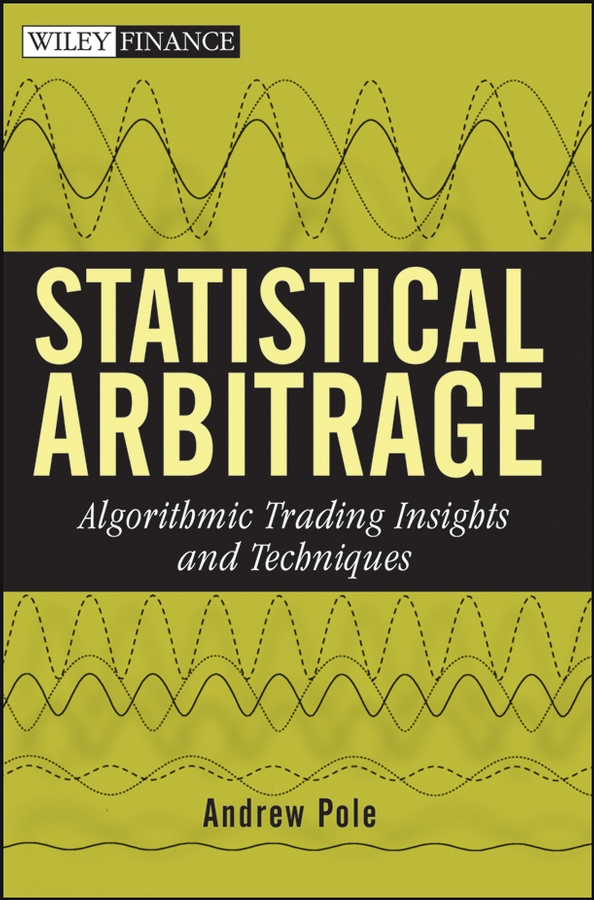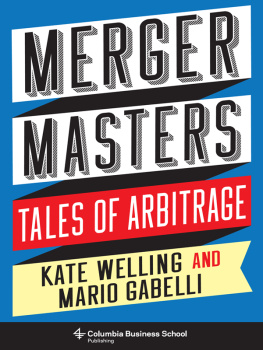Andrew Pole - Statistical Arbitrage
Here you can read online Andrew Pole - Statistical Arbitrage full text of the book (entire story) in english for free. Download pdf and epub, get meaning, cover and reviews about this ebook. year: 2011, genre: Romance novel. Description of the work, (preface) as well as reviews are available. Best literature library LitArk.com created for fans of good reading and offers a wide selection of genres:
Romance novel
Science fiction
Adventure
Detective
Science
History
Home and family
Prose
Art
Politics
Computer
Non-fiction
Religion
Business
Children
Humor
Choose a favorite category and find really read worthwhile books. Enjoy immersion in the world of imagination, feel the emotions of the characters or learn something new for yourself, make an fascinating discovery.

- Book:Statistical Arbitrage
- Author:
- Genre:
- Year:2011
- Rating:5 / 5
- Favourites:Add to favourites
- Your mark:
- 100
- 1
- 2
- 3
- 4
- 5
Statistical Arbitrage: summary, description and annotation
We offer to read an annotation, description, summary or preface (depends on what the author of the book "Statistical Arbitrage" wrote himself). If you haven't found the necessary information about the book — write in the comments, we will try to find it.
Statistical Arbitrage — read online for free the complete book (whole text) full work
Below is the text of the book, divided by pages. System saving the place of the last page read, allows you to conveniently read the book "Statistical Arbitrage" online for free, without having to search again every time where you left off. Put a bookmark, and you can go to the page where you finished reading at any time.
Font size:
Interval:
Bookmark:

Contents

Copyright 2007 by Andrew Pole. All rights reserved.
Published by John Wiley & Sons, Inc., Hoboken, New Jersey.
Published simultaneously in Canada.
Wiley Bicentennial logo: Richard J. Pacifico.
No part of this publication may be reproduced, stored in a retrieval system, or transmitted in any form or by any means, electronic, mechanical, photocopying, recording, scanning, or otherwise, except as permitted under Section 107 or 108 of the 1976 United States Copyright Act, without either the prior written permission of the Publisher, or authorization through payment of the appropriate per-copy fee to the Copyright Clearance Center, Inc., 222 Rosewood Drive, Danvers, MA 01923, (978) 750-8400, fax (978) 750-4470, or on the Web at www.copyright.com . Requests to the Publisher for permission should be addressed to the Permissions Department, John Wiley & Sons, Inc., 111 River Street, Hoboken, NJ 07030, (201) 748-6011, fax (201) 748-6008, or online at http://www.wiley.com/go/permission .
Limit of Liability/Disclaimer of Warranty: While the publisher and author have used their best efforts in preparing this book, they make no representations or warranties with respect to the accuracy or completeness of the contents of this book and specifically disclaim any implied warranties of merchantability or fitness for a particular purpose. No warranty may be created or extended by sales representatives or written sales materials. The advice and strategies contained herein may not be suitable for your situation. You should consult with a professional where appropriate. Neither the publisher nor author shall be liable for any loss of profit or any other commercial damages, including but not limited to special, incidental, consequential, or other damages.
For general information on our other products and services or for technical support, please contact our Customer Care Department within the United States at (800) 762-2974, outside the United States at (317) 572-3993 or fax (317) 572-4002.
Wiley also publishes its books in a variety of electronic formats. Some content that appears in print may not be available in electronic books. For more information about Wiley products, visit our Web site at www.wiley.com .
Library of Congress Cataloging-in-Publication Data:
Pole, Andrew, 1961
Statistical arbitrage: algorithmic trading insights and techniques / Andrew Pole.
p. cm. (Wiley finance series)
Includes bibliographical references and index.
ISBN 978-0-470-13844-1 (cloth)
1. Pairs trading. 2. ArbitrageMathematical models. 3. SpeculationMathematical models. I. Title.
HG4661.P65 2007
332.64'5 dc22
2007026257
ISBN 978-0-470-13844-1
Founded in 1807, John Wiley & Sons is the oldest independent publishing company in the United States. With offices in North America, Europe, Australia, and Asia. Wiley is globally committed to developing and marketing print and electronic products and services for our customers professional and personal knowledge and understanding.
The Wiley Finance series contains books written specifically for finance and investment professionals as well as sophisticated individual investors and their financial advisors. Book topics range from portfolio management to e-commerce, risk management, financial engineering, valuation, and financial instrument analysis, as well as much more.
For a list of available titles, visit our Web site at www.WileyFinance.com .
To Eliza and Marina
Preface
These pages tell the story of statistical arbitrage. It is both a history, describing the first days of the strategys genesis at Morgan Stanley in the 1980s through the performance challenging years of the early twenty-first century, and an exegesis of how and why it works. The presentation is from first principles and largely remains at the level of a basic analytical framework. Nearly all temptation to compose a technical treatise has been resisted with the goal of contributing a work that will be readily accessible to the larger portion of interested readership. I say nearly all: Chapter 7 and the appendix to Chapter 11 probably belong to the category of temptation not resisted. Much of what is done by more sophisticated practitioners is discussed in conceptual terms, with demonstrations restricted to models that will be familiar to most readers. The notion of a pair tradethe progenitor of statistical arbitrageis employed to this didactic end rather more broadly than actual trading utility admits. In adopting this approach, one runs the risk of the work being dismissed as a pairs trading manual; ones experience, intent, and aspirations for the text are more extensive, but the inevitability of the former is anticipated. In practical trading terms, the simple, unelaborated pair scheme is no longer very profitable, nonetheless it remains a valuable tool for explication, retaining the capacity to demonstrate insight, modeling, and analysis while not clouding matters through complexity. After a quarter century in the marketplace, for profitable schemes beyond paper understanding and illustration, one needs to add some structural complexity and analytical subtlety.
One elaboration alluded to in the text is the assembling of a set of similar pairs (without getting into much detail on what metrics are used to gauge the degree of similarity), often designated as a group. Modeling such groups can be done in several ways, with some practitioners preferring to anchor a group on a notional archetype, structuring forecasts in terms of deviation of tradable pairs from the archetype; others create a formal implementation of the cohort as a gestalt or a synthetic instrument. Both of those approaches, and others, can be formally analyzed as a hierarchical model, greatly in vogue (and greatly productive of insight and application) in mainstream statistical thinking for two decades; add to the standard static structure the dynamic element in a time series setting and one is very quickly building an analytical structure of greater sophistication than routinely used as the didactic tool in this book. Nonetheless, all such modeling developments rely on the insight and techniques detailed herein.
Those readers with deeper knowledge of mathematical and statistical science will, hopefully, quickly see where the presentation can be taken.
Maintaining focus on the structurally simple pair scheme invites readers to treat this book as an explicit how to manual. From this perspective, one may learn a reasonable history of the what and the how and a decent knowledge of why it is possible. Contemporary successful execution will require from the reader some additional thought and directed exploration as foregoing remarks have indicated. For that task, the book serves as a map showing major features and indicating where the reader must get out a compass and notebook. The old cartographers device Here be dragons might be usefully remembered when you venture thus.
The text has, unashamedly, a statisticians viewpoint: Models can be useful. Maintaining a models utility is one theme of the book. The statisticians preoccupation with understanding variationthe appreciation of the knowledge that ones models are wrong, though useful, and that the nature of the wrongness is illuminated by the structure of errors (discrepancies between observations and what a model predicts) is another theme of the book. Or, rather, not a distinct theme, but an overriding, guiding context for the material.
The notion of a pair trade is introduced in Chapter 1 and elaborated upon in Chapter 2. Following explication and exemplification, two simple theoretical models for the underlying phenomenon exploited by pairs, reversion, are proposed. These models are used throughout the text to study what is possible, illuminate how the possibilities might be exploited, consider what kinds of change would have negative impact on exploitation, and characterize the nature of the impact. Approaches for selecting a universe of instruments for modeling and trading are described. Consideration of change is introduced from this first toe dipping into analysis, because temporal dynamics underpin the entirety of the project. Without the dynamic there is no arbitrage.
Font size:
Interval:
Bookmark:
Similar books «Statistical Arbitrage»
Look at similar books to Statistical Arbitrage. We have selected literature similar in name and meaning in the hope of providing readers with more options to find new, interesting, not yet read works.
Discussion, reviews of the book Statistical Arbitrage and just readers' own opinions. Leave your comments, write what you think about the work, its meaning or the main characters. Specify what exactly you liked and what you didn't like, and why you think so.










